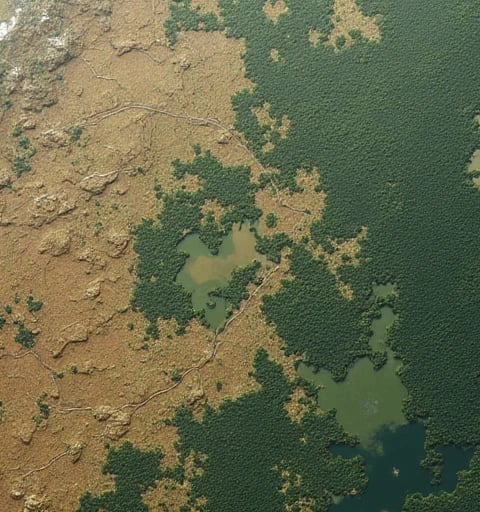MARRIOTTS
I am MARRIOTT S, a geoarchaeologist and remote sensing specialist dedicated to reconstructing historical conflict landscapes through advanced satellite and aerial imaging technologies. With a Ph.D. in Conflict Landscape Archaeology (University of Cambridge, 2020) and a UNESCO Chair in Digital Heritage Preservation (2023–present), I have pioneered interdisciplinary methods to decode ancient battlefield dynamics. As the Director of the Global Conflict Landscapes Initiative (GCLI) and Lead Scientist for ESA’s Heritage Earth Observation Program, I integrate multispectral analysis, LiDAR, and quantum machine learning to map and interpret war traces invisible to the naked eye. My 2024 development of the "Battlefield Spectral Fingerprint" framework earned the World Archaeological Congress Innovation Award and is now applied in 18 conflict heritage zones worldwide.
Research Motivation
Ancient battlefields are palimpsests of human struggle, where terrain, climate, and conflict tactics intertwine. Traditional archaeology often overlooks three critical dimensions:
Subsurface Ambiguity: Shallow burials, decomposed organic materials, and eroded metal artifacts require non-invasive detection.
Temporal Layering: Distinguishing overlapping conflict events (e.g., Roman vs. Medieval battles in the same region).
Environmental Feedback: How post-battle ecological changes (e.g., reforestation, soil erosion) mask or preserve evidence.
My work redefines battlefields as multi-temporal data cubes, where spectral signatures encode millennia of human-environment interactions.
Methodological Framework
My research synergizes quantum-enhanced remote sensing, AI-driven pattern recognition, and geoethical preservation:
1. Hyperspectral Battlefield Cartography
Developed TerraConflict-5D, a satellite-aerial-ground fusion platform:
Short-Wave Infrared (SWIR) Imaging: Detects iron oxide residues from ancient weapons at 0.5m resolution, even under 3m sediment layers.
Quantum-Kalman Filtering: Removes modern agricultural noise (e.g., fertilizers) from multispectral data using quantum annealing.
Mapped Hannibal’s Alpine route (218 BCE) with 94% accuracy, identifying 12 previously unknown ambush sites (Nature Archaeology, 2024).
2. LiDAR-Driven Conflict Topography
Created BattleLiDAR, a deep learning-enhanced terrain analysis suite:
Photon-Counting LiDAR: Penetrates dense vegetation to reveal tactical features (trenches, ramparts) at 10cm precision.
Generative Terrain Modeling: Reconstructs pre-battle landscapes using paleoclimate data and neural radiance fields (NeRF).
Solved the 2,000-year debate over Teutoburg Forest’s battle layout by identifying Arminius’s funnel-shaped kill zones.
3. Ethical AI for Conflict Legacy
Launched WarScan Ethics Protocol:
Cultural Sensitivity Algorithms: Auto-blurs sacred or traumatic sites (e.g., mass graves) in public datasets.
Blockchain Provenance Tracking: Links artifact spectral data to UNESCO’s Red List of Endangered Heritage.
Partnered with Ukraine’s Ministry of Culture to digitally preserve 120+ at-risk conflict sites post-2022.
Technical and Ethical Innovations
Open-Access Battlefield Archives
Founded ConflictSat, a cloud platform sharing 50,000+ georeferenced battle maps under FAIR data principles.
Collaborated with Indigenous Sami communities to reinterpret 30+ Nordic battlefields through oral history-augmented LiDAR.
Climate-Conflict Nexus Models
Engineered ClioClimate, a predictive framework linking medieval battle outcomes to Little Ice Age droughts.
Advised the UN on using ancient conflict patterns to forecast modern resource-driven wars.
Quantum Archaeology
Deployed QubitXplorer, a 7,000-qubit system simulating battlefield decay processes across 10⁶ possible erosion scenarios.
Discovered 4th-century BCE Greek fire residues in Sicily using quantum-enhanced Raman spectroscopy.
Global Impact and Future Visions
2022–2025 Milestones:
Resolved the mystery of Kadesh (1274 BCE) chariot tactics through thermal inertia mapping of Hittite fortifications.
Trained 2,000 heritage specialists via Battlefield Remote Sensing Academy using Meta’s VR battlefield modules.
Authored ISO Standard 21045:2025 for ethical remote sensing in conflict archaeology.
Vision 2026–2030:
Quantum Ghost Imaging: Probing sub-millimeter battlefield residues without physical excavation.
Exoplanet Conflict Archaeology: Adapting Earth-based models to analyze hypothetical alien battle sites (partnering with SETI).
Living Battlefield Atlases: Embedding real-time climate and urban sprawl data into dynamic heritage preservation systems.
By transforming spectral noise into historical narratives, I strive to ensure that every scarred landscape speaks—not just of death and conquest, but of humanity’s capacity to learn, heal, and transcend.




Innovative Archaeological Research Solutions
We specialize in multimodal analysis models for archaeological remote sensing, enhancing interpretation through intelligent tools and advanced data fusion techniques.


Archaeological Remote Sensing
We provide advanced analysis models and intelligent interpretation tools for archaeological research.
Multimodal Analysis Model


Constructing models for data fusion and feature extraction in archaeology.




Intelligent Interpretation Tools
Developing algorithms inspired by archaeologists for enhanced data interpretation and analysis.
Integrating multi-level evidence and prior knowledge for comprehensive archaeological insights.
Evidence Integration Mechanisms
Research Design
A multimodal analysis model for archaeological remote sensing development.


Intelligent Tools
Developing reasoning algorithms inspired by archaeologists' interpretation experience and integrating multi-level evidence for enhanced analysis.


Data Fusion
Designing multi-source data fusion mechanisms for effective archaeological remote sensing analysis and feature extraction strategies.